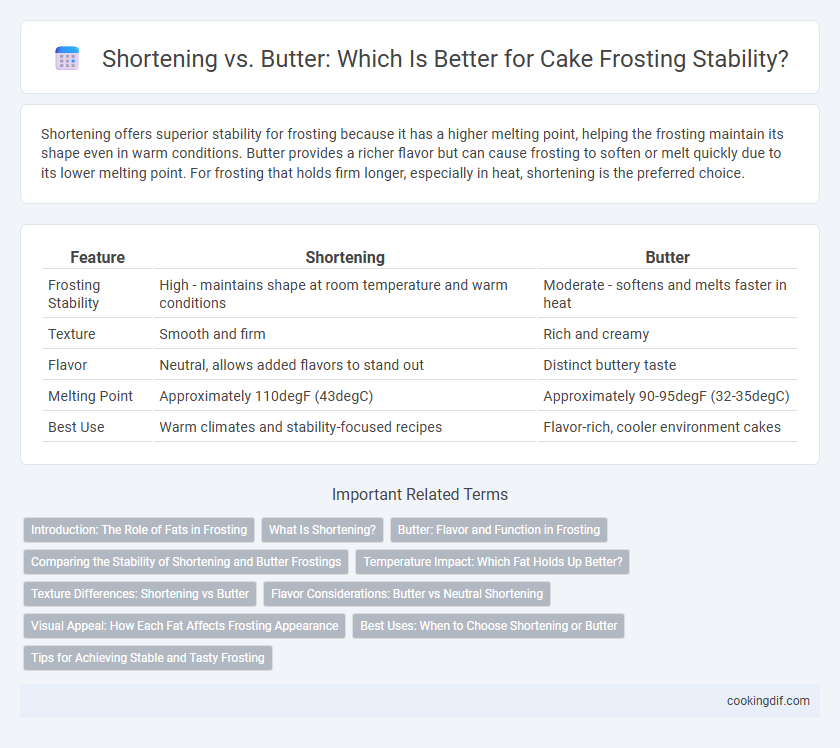Shortening offers superior stability for frosting because it has a higher melting point, helping the frosting maintain its shape even in warm conditions. Butter provides a richer flavor but can cause frosting to soften or melt quickly due to its lower melting point. For frosting that holds firm longer, especially in heat, shortening is the preferred choice.
Table of Comparison
| Feature | Shortening | Butter |
|---|---|---|
| Frosting Stability | High - maintains shape at room temperature and warm conditions | Moderate - softens and melts faster in heat |
| Texture | Smooth and firm | Rich and creamy |
| Flavor | Neutral, allows added flavors to stand out | Distinct buttery taste |
| Melting Point | Approximately 110degF (43degC) | Approximately 90-95degF (32-35degC) |
| Best Use | Warm climates and stability-focused recipes | Flavor-rich, cooler environment cakes |
Introduction: The Role of Fats in Frosting
Fats play a crucial role in frosting stability by influencing texture, spreadability, and shelf life. Shortening, composed of hydrogenated vegetable oils, offers a higher melting point, resulting in a more stable and less greasy frosting that holds its shape well at room temperature. Butter, with its natural water content and lower melting point, provides superior flavor but can cause frosting to be softer and more prone to melting in warmer conditions.
What Is Shortening?
Shortening is a solid fat made from vegetable oils that remains stable at room temperature, providing superior structural integrity to cake frostings compared to butter. Its high melting point prevents frosting from melting easily, ensuring a smooth and firm texture ideal for intricate cake decorations and warm climates. Unlike butter, shortening contains no water, which helps to maintain frosting stability and extend shelf life.
Butter: Flavor and Function in Frosting
Butter enhances frosting with rich, creamy flavor and contributes to a smooth, spreadable texture ideal for decorating cakes. Its natural fat content provides a stable emulsion, improving frosting stability by preventing separation under moderate temperature changes. While butter offers superior taste, combining it with shortening can balance flavor with increased firmness for optimal frosting performance.
Comparing the Stability of Shortening and Butter Frostings
Shortening-based frostings exhibit greater stability than butter frostings due to their higher melting point and resistance to heat, ensuring a firmer texture that holds shape longer in warm conditions. Butter frosting offers superior flavor but is more prone to melting and softening, especially above 70degF (21degC), which can compromise decorative designs. For cake decorators prioritizing structure and durability in varied climates, shortening frosting provides a more reliable option for maintaining frosting stability over time.
Temperature Impact: Which Fat Holds Up Better?
Shortening maintains frosting stability better than butter at higher temperatures due to its higher melting point, preventing frosting from becoming runny or losing structure. Butter's lower melting point causes frosting to soften quickly when exposed to warmth, risking collapse in warmer environments. For consistent texture and durability, especially in hot climates, shortening is the preferred fat for reliable frosting stability.
Texture Differences: Shortening vs Butter
Shortening provides a smooth and stable texture in frosting due to its higher melting point, resulting in a consistent and firm finish ideal for decorating. Butter offers a rich flavor but creates a softer, less stable frosting that can melt easily at room temperature, often leading to a more delicate and creamy mouthfeel. The choice between shortening and butter significantly impacts the frosting's texture, stability, and workability during cake decoration.
Flavor Considerations: Butter vs Neutral Shortening
Butter imparts a rich, creamy flavor with natural dairy notes that enhance the overall taste of frosting, making it a preferred choice for those seeking depth and authenticity. Neutral shortening provides a more neutral base that allows other flavorings to shine without adding any distinct taste, ideal for preserving delicate or diverse flavor profiles. The choice between butter and shortening impacts not only frosting stability but also the flavor intensity and texture of the finished cake.
Visual Appeal: How Each Fat Affects Frosting Appearance
Shortening creates a smoother, firmer frosting that maintains sharp, clean edges and vibrant colors, enhancing the cake's visual appeal. Butter-based frostings tend to be softer with a slightly glossy finish, which can result in less defined piping but a rich, creamy look. The choice between shortening and butter impacts the frosting's texture and stability, directly influencing how well decorative details hold up over time.
Best Uses: When to Choose Shortening or Butter
Shortening provides superior stability and maintains frosting consistency at higher temperatures, making it ideal for intricate cake decorations and warm climates. Butter offers a rich flavor preferred for simple cake frostings and cooler environments but may soften or melt more quickly. Choose shortening for durability and butter for taste to best suit the cake's presentation and storage conditions.
Tips for Achieving Stable and Tasty Frosting
Using shortening in frosting enhances stability due to its higher melting point, making it ideal for warm environments and intricate cake designs. Butter provides rich flavor but can soften and lose structure quickly, so refrigerating the frosted cake helps maintain firmness. Combining butter with a small amount of shortening balances taste and stability, while incorporating powdered sugar and chilling between frosting layers also improves texture and durability.
Shortening vs Butter for frosting stability Infographic

 cookingdif.com
cookingdif.com